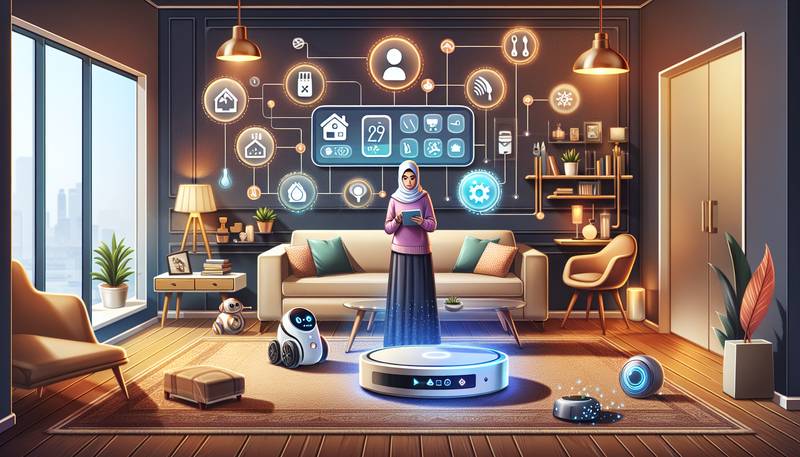Home Automation Basics: Getting Started with Smart Technology

Introduction
Welcome aboard the smart home bandwagon! Are you ready to embrace the future, where your home caters to your every whim with just a mere command? Home automation is no longer a scene from a sci-fi movie; it's reality and becoming more accessible every day. Imagine walking into your house, and the lights automatically switching on, your favorite music starts playing, and the thermostat adjusts to your perfect temperature – all without lifting a finger. This isn't magic; it's smart technology at work, and we're here to guide you through the basics of getting started. By the end of this guide, you'll understand what home automation is, how to pick the right gadgets, set them up, and control your smart home in a way that feels like you have a personal genie at your service!
Understanding Home Automation
The concept of home automation might seem complex at first, but it is essentially the integration of technology into the home environment to facilitate convenience, comfort, and security. Some people might also refer to it as a "smart home" or "connected home." These systems allow you to control your home's appliances, lighting, heating, and security systems remotely or through a centralized unit within the house. The great thing about modern home automation is that it's modular, meaning you can start small—maybe with just a smart speaker or lightbulbs—and expand your setup as you get more comfortable with the technology. By doing so, you're not just upgrading your home; you're also taking a step towards energy efficiency and even better home security. Ultimately, home automation is about making your home work for you, automating tasks so you can better enjoy the space you live in.
Picking Your Players: Choosing the Right Devices
Starting your smart home journey begins with selecting devices that will bring not only value but also harmony into your living space. The market is flooded with gadgets claiming to transform your life, but the key is to identify what conveniences, securities, or efficiencies you prioritize. Here are the main categories to consider:Smart Speakers and Hubs: Think of these as the quarterbacks of your team. Devices like Google Home, Amazon Echo, and Apple HomePod are the central points of control that connect and command other smart devices through voice commands or smartphone apps.Lighting: Brands like Philips Hue and LIFX offer smart lightbulbs that you can control with an app or through your smart hub. They can change colors, dim on command, and even sync with your music or TV.Thermostats: Devices like Nest or Ecobee help efficiently manage your home's temperature, learn your preferences over time, and can be controlled remotely.Security Cameras and Alarms: Systems from Ring, Arlo, or Nest provide peace of mind with features like real-time surveillance accessible through your phone, alerts for movement, and integration with other smart home devices.Smart Plugs and Switches: Simple yet powerful, these allow you to turn any 'dumb' appliance into a smart one by giving you control over power supply.When choosing devices, consider their compatibility with each other and your existing tech ecosystem, ease of use, installation requirements, and customer support offered by the manufacturer.
Installation: Setting Up Your Devices
Once you've picked out your team of devices, it's time to set them up. Start by ensuring your home Wi-Fi network is robust and secure—after all, it's the backbone of your smart home. Most devices will have a companion app to walk you through installation, and here's a general step-by-step:
- Download the device's app on your smartphone or tablet.
- Plug in or install the device (this may involve a bit of DIY, like replacing a light switch or thermostat).
- Connect the device to your home network through the app, usually just a matter of following on-screen instructions.
- Give your device a name and assign it to a room in the app for easy management.
- Test it out to make sure everything's working smoothly.
For devices requiring voice commands or smart hub integration, you'll usually have to go a step further and enable specific skills or settings within the hub's app. This can be done by searching for your device name and following the prompts provided. Some devices require continuous power, others operate on batteries, and some can even be integrated into your existing home wiring – so always follow the manufacturer's guidelines closely.
Command Center: Controlling Your Smart Home
With your devices up and running, you'll want to know how to best control them. The most common methods are through smartphone apps or voice commands via smart hubs. Apps not only give you control but also provide insights into your usage, allowing you to set schedules or automate tasks. For instance, setting a routine that gradually brightens the lights and plays a gentle playlist every morning as a personal wake-up call.Voice commands add another layer of convenience, allowing you to adjust settings or control devices hands-free – a boon especially when cooking, carrying laundry, or in the middle of a workout. You might say something like, "Hey Google, turn off all lights," and watch your home respond instantly. Some advanced smart home systems also offer control panels - wall-mounted touch screens that offer a more traditional, tactile interaction with your smart home. They can be particularly useful for older individuals or guests who might not be as familiar with voice or app controls.
Stay tuned as in the next sections we'll delve deeper into integrating these devices to create a truly connected home, and ensuring that your smart home is also a secure one.
Creating a Symphony: Integrating Your Devices
Now that you have a collection of smart devices, the next step is to integrate them to work in concert. Integration is what turns a group of smart products into a fully-automated, smart home experience. Many smart devices can be linked through a centralized smart home hub or platform, such as Apple HomeKit, Google Home, or Amazon Alexa. Here’s how to make the magic happen:
- First, double-check that all of your devices are compatible with your chosen platform. Compatibility information is typically found on the product’s packaging or website.
- Next, within the platform's app, look for the option to add new devices and select the devices you want to integrate. This will often be done through a simple scan of a QR code or inputting a serial number.
- Once added, you can begin creating ‘scenes’ or ‘routines’. These are sets of actions that occur under certain conditions, such as a "Good Morning" scene that opens the blinds, turns on the coffee maker, and plays the news.
- Test these integrations to refine the settings to your preference, ensuring that actions are triggered exactly when and how you want them.
By properly integrating your devices, you can unlock your smart home’s full potential, making everyday tasks simpler and giving you more time to enjoy the things you love. Whether you want your lights to flash when your security camera detects movement or your thermostat to lower the temperature when you leave the house, integration allows for a seamless and intuitive smart home experience.
Fortress of the Future: Ensuring Smart Home Security
Security is an essential aspect of any home, and smart technology offers new layers of protection. However, with all these connected devices, it’s important to ensure that your smart home is not just convenient, but also secure from potential digital threats. Here’s how to keep your smart home safe:
- Practice good password hygiene by creating unique, strong passwords for your Wi-Fi network and each smart device. Consider using a password manager to keep track of them all.
- Enable two-factor authentication where available to add an extra layer of security to your devices and accounts.
- Keep your firmware up to date on all devices to ensure you have the latest security patches and improvements.
- Use a secure Wi-Fi network and consider separating your smart home devices on a guest network away from your main personal network.
- Be aware of physical access to your smart home devices, as some might be reset or paired to another account if someone has direct access to them.
By taking these steps, you can help protect your smart home from unauthorized access and ensure that your smart devices only serve you and your family.
Conclusion: Embrace Your Smart Home Journey
Congratulations, you’re now well on your way to becoming a smart home aficionado! You've learned about the exciting possibilities of home automation, how to choose your devices, set them up, control them, integrate them, and secure them. It's a lot to take in, but remember - the beauty of smart homes is their scalability and adaptability. Start small, get comfortable with the technology, and grow your smart home at your pace. Before you know it, you'll be living in a home that not only simplifies your life but also takes care of you, learning and adapting to your personal preferences. So here's to your smart home journey - may it be filled with convenience, entertainment, and fortified security. Because at the end of the day, a home is more than just a collection of gadgets and routines; it's where the heart is - smart or not.


